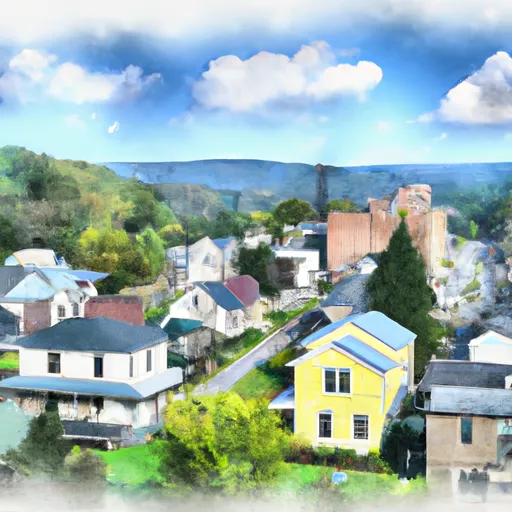-
 Snoflo Premium
Snoflo Premium
Get unlimited access to all our content
With no Ad interruptions! - Start Your Free Trial Login with existing account
West-Newton
Eden Index
Climate
8.3
•
Recreation
2.8
•
Community
3.8
•
Safeguard
5.2/10

West Newton is a charming small town located in southwestern Pennsylvania. The region experiences a humid continental climate with warm summers and cold winters. Summers are typically mild, with average temperatures ranging from 70°F to 80°F, while winters are cold, with temperatures averaging between 20°F and 30°F. Precipitation is evenly distributed throughout the year, with snowfall occurring during the winter months.
The town is nestled along the banks of the Youghiogheny River, which is a prominent hydrological feature in the area. The river offers various recreational opportunities, including fishing, boating, and kayaking. Additionally, the Great Allegheny Passage, a scenic trail that stretches over 150 miles, passes through West Newton. This trail is perfect for outdoor enthusiasts, offering hiking, biking, and jogging opportunities.
Other outdoor recreation opportunities in West Newton include nearby state parks such as Cedar Creek and Laurel Hill State Park. These parks provide opportunities for camping, picnicking, hiking, and wildlife viewing. With its pleasant climate and access to natural landmarks, West Newton offers an array of outdoor activities for visitors and locals alike.
What is the Eden Index?
The Snoflo Eden Index serves as a comprehensive rating system for regions, evaluating their desirability through a holistic assessment of climate health, outdoor recreation opportunities, and natural disaster risk, acknowledging the profound impact of these factors on livability and well-being.
Climate Health Indicator (CHI): 8.3
West-Newton receives approximately
1019mm of rain per year,
with humidity levels near 83%
and air temperatures averaging around
11°C.
West-Newton has a plant hardyness factor of
6, meaning
plants and agriculture in this region thrive during a short period during spring and early summer. Most
plants will die off during the colder winter months.
By considering the ideal temperature range, reliable water supplies, clean air, and stable seasonal rain or snowpacks, the Climate Health Indicator (CHI) underscores the significance of a healthy climate as the foundation for quality living.
A healthy climate is paramount for ensuring a high quality of life and livability in a region, fostering both physical well-being and environmental harmony. This can be characterized by ideal temperatures, reliable access to water supplies, clean air, and consistent seasonal rain or snowpacks.
Weather Forecast
Streamflow Conditions
Monongahela
Area Rivers
Monongahela
Snowpack Depths
Monongahela
Reservoir Storage Capacity
Monongahela
Groundwater Levels
Recreational Opportunity Index (ROI): 2.8
The Recreational Opportunity Index (ROI) recognizes the value of outdoor recreational options, such as parks, hiking trails, camping sites, and fishing spots, while acknowledging that climate plays a pivotal role in ensuring the comfort and consistency of these experiences.
Access to outdoor recreational opportunities, encompassing activities such as parks, hiking, camping, and fishing, is crucial for overall well-being, and the climate plays a pivotal role in enabling and enhancing these experiences, ensuring that individuals can engage in nature-based activities comfortably and consistently.
Camping Areas
| Campground | Campsites | Reservations | Toilets | Showers | Elevation |
|---|---|---|---|---|---|
| Coopers Rock State Forest | None | 2,154 ft | |||
| Chestnut Ridge Regional Park | None | 2,268 ft |
Nearby Fishing
Nearby Ski Areas
Catastrophe Safeguard Index (CSI):
The Catastrophe Safeguard Index (CSI) recognizes that natural disaster risk, encompassing floods, fires, hurricanes, and tornadoes, can drastically affect safety and the overall appeal of an area.
The level of natural disaster risk in a region significantly affects safety and the overall livability, with climate change amplifying these risks by potentially increasing the frequency and intensity of events like floods, fires, hurricanes, and tornadoes, thereby posing substantial challenges to community resilience and well-being.
Community Resilience Indicator (CRI): 3.8
The Community Resilience Indicator (CRI) recognizes that education, healthcare, and socioeconomics are crucial to the well-being of a region. The CRI acknowledges the profound impact of these elements on residents' overall quality of life. By evaluating educational resources, healthcare accessibility, and economic inclusivity, the index captures the essential aspects that contribute to a thriving community, fostering resident satisfaction, equity, and social cohesion.

